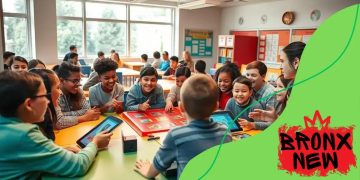Hybrid learning models in higher education: a new approach

Hybrid learning models in higher education combine traditional classroom teaching with online elements, enhancing flexibility, engagement, and personalized learning experiences while utilizing technology to meet diverse student needs.
Hybrid learning models in higher education are reshaping educational experiences, blending traditional and digital methods. Have you ever wondered how this approach impacts student engagement and success?
Understanding hybrid learning models
Understanding hybrid learning models is essential as they combine the best aspects of in-person and online education. Many institutions are now recognizing the flexibility and accessibility these models offer to students.
What are hybrid learning models?
Hybrid learning models mix traditional face-to-face classroom experiences with online learning elements. This approach allows students to engage with material in various ways, catering to different learning styles.
- Flexibility to learn at their own pace
- Increased access to resources
- Enhanced interaction with peers and instructors
For instance, a student can attend lectures in person but complete assignments online. This method promotes active participation, which can lead to better retention of information. These models are designed to leverage technology effectively, ensuring that all students receive a comprehensive educational experience.
Benefits of hybrid models
Using a hybrid learning model, students can enjoy several advantages. They tend to be more engaged when they have options. This flexibility helps accommodate various lifestyles, especially for those balancing studies with work or family.
- Improved motivation through varied learning formats
- Development of digital skills
- Encouragement of self-directed learning
Moreover, instructors can tailor their teaching methods to suit the needs of their students better. They can incorporate more interactive elements such as quizzes, discussions, and projects into their lessons. This leads to a richer learning environment that caters to a wider array of academic preferences.
In conclusion, hybrid learning models are paving the way for a more versatile and inclusive educational landscape. By embracing this approach, educators and students alike can adapt to the challenges of modern learning, finding new pathways to success.
Advantages of hybrid learning in colleges
The advantages of hybrid learning in colleges are becoming increasingly clear as more institutions adopt this innovative approach. This model allows for a combination of traditional classroom experiences and online learning, which can greatly enhance the educational journey.
Flexibility for Students
One of the key benefits is the flexibility it offers. Students can choose to attend classes in person or participate online, making it easier to balance their education with work or personal commitments. This adaptability helps in accommodating diverse learning styles.
- Enhanced accessibility to course materials
- Ability to learn at their own pace
- Options for live interactions or recorded sessions
As a result, students can tailor their learning experiences to better fit their needs. This personal approach often leads to improved engagement in their studies. Many students report feeling more motivated when they can control their learning environment.
Improved Learning Outcomes
Another significant advantage of hybrid learning is the potential for better learning outcomes. By merging online and in-person components, students can access a variety of learning resources. This variety often facilitates deeper understanding and retention of course material.
- Increased interaction with peers and instructors
- Opportunities for collaborative projects
- Access to multimedia educational tools
Moreover, the online component enables students to revisit lectures or learning resources whenever they need. This kind of on-demand learning cultivates a deeper engagement with the content, which can significantly aid in mastering complex topics.
Overall, the hybrid model encourages a more interactive and involved educational experience that benefits both students and educators alike. Embracing this change can lead to a more effective learning environment.
Challenges faced by institutions

The challenges faced by institutions implementing hybrid learning models can vary widely but remain significant. Ensuring a smooth transition to this blended approach requires careful planning and support.
Technology Integration
One major challenge is the integration of technology. Institutions must equip classrooms with the necessary tools and platforms to support both in-person and online learning. This involves investing in high-quality video conferencing software, digital collaboration tools, and a reliable internet connection.
- Need for consistent software and hardware
- Training staff in new technologies
- Maintaining technical support for users
Without proper technology, the learning experience can be disrupted, leaving students and instructors frustrated. This factor can place a significant burden on the resources of educational institutions.
Engagement and Support
Another challenge is ensuring that all students remain engaged, whether they are learning online or in person. Some students may feel isolated or disconnected during remote sessions, leading to lower participation rates.
- Creating interactive online content
- Facilitating group projects across different formats
- Providing adequate support systems
Instructors must find ways to foster collaboration and community among students, regardless of the format they are in. This demand requires educators to be flexible and creative, developing new strategies to engage their students effectively.
Moreover, balancing the workload of faculty members can also be a challenge. Educators must prepare for two types of learning environments, which can lead to increased workload and possible burnout if not managed properly.
Addressing these challenges necessitates ongoing support, training, and resources for both students and faculty. As institutions continue to adapt to hybrid learning, identifying and overcoming these obstacles will be vital for success in enhancing educational experiences.
Best practices for implementing hybrid models
Best practices for implementing hybrid learning models can greatly enhance the educational experience for both students and educators. By following these key strategies, institutions can create an effective learning environment that meets diverse needs.
Start with Clear Learning Objectives
One effective approach is to set clear learning objectives. Understanding what students need to learn helps guide the course structure. When students know the goals, they can focus their efforts more effectively.
- Define what students should achieve by the end of the course
- Communicate these goals clearly at the start
- Adjust objectives based on feedback and assessment
By having these objectives in place, both instructors and students can stay on track throughout the course. This clarity fosters a stronger sense of purpose in the learning journey.
Utilize Engaging Technology
Incorporating engaging technology is another crucial best practice. Utilizing a mix of digital tools can boost student participation and enhance learning experiences. Resources like learning management systems, interactive software, and forums can create a more dynamic environment.
- Choose user-friendly platforms for ease of use
- Include tools that promote collaboration
- Provide training sessions for students and staff on how to use new technologies
When technology is effectively integrated, it helps bridge the gap between in-person and online learning, making the entire experience seamless.
Moreover, offering flexible learning pathways supports varying student schedules. This flexibility encourages students to engage with course content in ways that suit their personal and professional lives. By allowing students to participate in both live sessions and recorded lectures, institutions can cater to diverse learning preferences.
Seek Continuous Feedback
Finally, seeking continuous feedback is vital. Regular check-ins with students can provide valuable insights into what is working and what needs improvement.
- Conduct surveys to gauge student satisfaction
- Facilitate open discussions about the learning experience
- Adjust teaching methods based on student feedback
This practice not only helps instructors refine their approaches but also empowers students to take an active role in their learning. By being responsive, institutions can create a hybrid learning environment that evolves and adapts to meet the needs of all participants.
Future trends in hybrid education
The future trends in hybrid education are set to shape the way learning takes place across the globe. As technology continues to evolve, so will the methods of teaching and learning, creating exciting opportunities for both students and educators.
Increased Use of Artificial Intelligence
One significant trend is the increased use of artificial intelligence in education. AI tools can provide personalized learning experiences by adapting content to meet the needs of each student. This assistance helps students learn at their own pace and style.
- AI-driven tutoring systems for additional support
- Intelligent learning platforms that analyze progress
- Automated administrative tasks for educators
This means instructors can spend more time engaging with students while technology assists with grading and assessments. By leveraging AI, institutions can enhance learning outcomes while reducing the workload on teachers.
Focus on Collaborative Learning
Another important trend is a greater emphasis on collaborative learning. Future hybrid models will likely prioritize group projects and peer interactions, whether students are in-person or online. This approach fosters teamwork and communication skills essential in today’s workforce.
- Using breakout rooms in virtual classes for group work
- Creating platforms for peer-to-peer feedback
- Encouraging interdisciplinary projects across different subjects
By incorporating more collaboration, students can learn from one another and develop essential social skills. In today’s digital world, these interactions can also extend to global collaboration, connecting students from different countries and cultures.
Additionally, the growing trend of micro-credentials offers a more flexible approach to education. Students can earn certifications in specific skills or topics without completing an entire degree. This allows for targeted learning experiences that can directly relate to industry needs.
Enhanced Learning Analytics
Lastly, enhanced learning analytics will play a crucial role in hybrid education’s future. By analyzing data related to student performance and engagement, institutions can adjust strategies to improve retention and success rates. This data-driven approach enables more informed decision-making regarding curriculum development and teaching methods.
- Tracking student engagement metrics in real-time
- Identifying struggling students early for timely intervention
- Utilizing data to refine course content and delivery
As the landscape of education continues to evolve, these trends will help institutions prepare for the challenges and opportunities ahead. Embracing these innovations can lead to a more effective and engaging learning environment.
In conclusion, hybrid learning models offer exciting possibilities for higher education. They blend traditional and online methods to create a flexible and engaging environment for students. By embracing technology, fostering collaboration, and continuously adapting to feedback, institutions can improve the learning experience. As we look to the future, the trends of AI integration, personalized learning, and data-driven strategies will shape the way we educate. This evolution leads to better outcomes and prepares students for a rapidly changing world.
FAQ – Frequently Asked Questions about Hybrid Learning Models
What are hybrid learning models?
Hybrid learning models combine traditional face-to-face instruction with online learning elements, offering a flexible education experience.
What are the advantages of hybrid learning?
Advantages include flexibility for students, improved engagement, and access to diverse resources that cater to various learning styles.
What challenges do institutions face when implementing hybrid learning?
Institutions may encounter challenges like technology integration, ensuring student engagement, and managing faculty workload.
What are the future trends in hybrid education?
Future trends include increased use of AI for personalized learning, a focus on collaborative projects, and enhanced learning analytics to improve educational outcomes.





